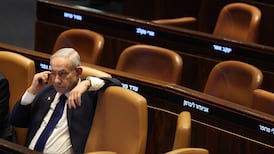Now in its sixth year, the war of attrition in Syria grinds on, its myriad factions and their foreign sponsors seemingly locked in a bloody cycle of mutually assured stalemate. Yet while the grim toll of death and displacement continued its inexorable rise this year – more than 400,000 people have now been killed and a further 11 million forced to flee their homes – the conflict evolved in ways that could turn out to be decisive.
It has been a crisis of relentless escalation. What began in March 2011 as an uprising against the rule of President Bashar al-Assad turned into a civil war before metastasising into a proxy war that drew in all the regional powers. But in the past 12 months, notwithstanding the continuing horrors faced by the remaining civilian population across the country, the trend has been towards a contraction in the theatre of war. Owing partly to gains by forces loyal to Assad, as well as Jordan’s intensive policing of the southern border, hostilities are now heavily concentrated in northern Syria, whose map is a complex patchwork of fiefdoms controlled by rival factions. Since February, more than 95 per cent of the fighting has taken place in the north, according to the Carter Centre think tank.
Humanitarian catastrophe
The focus has been chiefly on Aleppo, Syria's largest pre-war city and the site of a ferocious campaign by the Syrian government, aided by Russian forces and Iranian-backed militias, to dislodge rebel factions who remained in control in the east. The opposition-held sectors of eastern Aleppo were surrounded in July, staunching the flow of food and medical supplies and accelerating the onset of a humanitarian catastrophe in an area that was home to 275,000 people. Months of Russian-backed artillery bombardment, which included the targeting of hospitals and vital infrastructure, eventually overwhelmed defence lines. By mid-December, a Syrian ground advance had pushed through almost two-thirds of the eastern Aleppo territory long controlled by the rebels, among them the jihadist coalition Jabhat Fatah al-Sham (a rebranded al-Qaeda affiliate formerly known as Jabhat al-Nusra), and Bashar looked set to take almost total control of the city.
Aleppo would be a big prize. The fall of the city would mean the Syrian government would be in control in the country's five largest urban areas and most of its more populous west. It would leave the rebels with only the northern province of Idlib and a few isolated pockets of territory in Aleppo and Homs provinces and around the capital, Damascus. Such losses for the rebels would dramatically reduce their chances of seeing Assad ousted, at least as long as an emboldened Russia remains committed to keeping him in power.
Urban base
Farther west, Islamic State suffered major setbacks in 2016. Despite dealing an embarrassing blow to Assad by returning to the city of Palmyra in December, the jihadist group, also known as Isis, lost ground in more strategically important areas. Notably, it lost its once long stretch of territory on the border with Turkey, an important source of supplies and recruits, as well as the city of Manbij. Isis is fighting an assault on its most important possession in Iraq, the city of Mosul. Defeat there would be a heavy blow, robbing the group of its tax base, its oil fields and biggest urban base. It is also under attack north of Raqqa, its Syrian capital, following a series of air strikes that have killed some of its most important leaders. Yet while Islamic State's territory steadily shrunk in Syria and Iraq, western governments warned that the threat of attacks by its supporters in Europe was higher than ever.
It was widely speculated that the timing of the Aleppo offensive was partly linked to the US presidential election. A victory for Assad in the city would present the incoming president with a fait accompli. It was also known that Hillary Clinton was in favour of imposing a no-fly zone over Syria, a stance that her critics warned could, by requiring the Americans first to destroy Syrian air defences, set off a dangerous confrontation with the Russians. In president-elect Donald Trump, in contrast, the Russians see a potential ally while Assad sees an avowed critic of US efforts at regime change in Iraq and Libya who appears agnostic about the prospect of the Syrian president holding on to power. Trump's stated positions on Syria include "bombing the hell" out of Isis and calling for more support for the Kurds, which would pit the US against Turkey, a Nato ally. Beyond that, his plan to end the crisis – the biggest foreign policy failure on the record of the outgoing president, Barack Obama – remains largely unknown.
Diplomatic shuttling
Yet even if Isis is defeated in the Levant and Assad quashes the rebellion, the prospects for an enduring settlement look as remote as ever. Intensive diplomatic shuttling this year yielded temporary, localised ceasefires, but each one collapsed under the weight of mutual mistrust among the combatant parties and their sponsors. Taking Aleppo would strengthen Assad’s grip on power, but his legitimacy is in tatters, his future entirely contingent on the wishes of his foreign supporters. And if the war is indeed entering its closing stretch, any attempt by Damascus to reassert its authority over the Sunni majority could be met with a guerrilla insurgency that would prolong the horror and impede any attempts to rebuild a shattered country.













